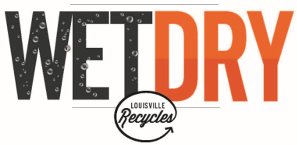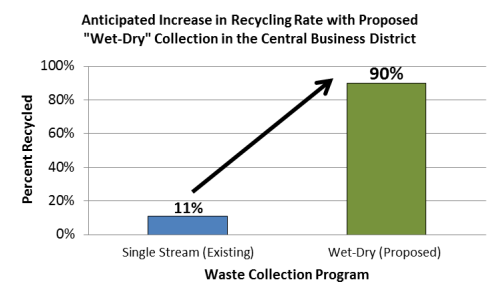Louisville’s Central Business District is going green in a big way! Louisville Metro is launching a cutting edge “Wet-Dry” recycling pilot program for all Metro-serviced businesses and residents in the Central Business District. This program is expected to launch in March 2014. Click here to contact a QRS Specialist to find out more about the Wet-Dry recycling program and what it means for your business or residence.

This program is the first of its kind in this region and truly changes the way we think about waste. Here, garbage is viewed first as a resource, not just something that is thrown away.
What is “Wet-Dry”? Wet-Dry refers to the way waste is separated for curbside collection. ‘Wet’ waste includes foods, liquids, used tissues, and dirty paper towels. This waste is most common in bathrooms, breakrooms, and kitchen areas.
‘Dry’ waste is basically everything else. Plastics, paper, clean cardboard, aluminum containers, metals, glass, etc. In most office settings, well over 75% of waste is recyclable - in some cases it is over 90%! This program allows us to recycle almost all of this material . . . and you don’t even have to throw it in a recycle bin!
Why is this a big deal? It is the first municipal program of its kind in the region and among a very few in the entire country. Under existing conditions, only 11% of waste collected by Louisville Metro in the Central Business District is recycled.
With this program, nearly 90% of the stuff we throw away will be recycled!

We are here to help. We want to ensure you have all the resources andinformation necessary to fully embrace this new program. After all, its success is dependent upon your participation. In the coming weeks, you will hear more about this program and what you can do to help. To learn more, find the heading below that best matches your needs.
Food and coffee grinds will be recycled into high quality compost! Food generating businesses will have two types of carts. The brown cart(s) will be for organic (food) waste only. You can keep these carts in your kitchen area - they will not be seen by customers. It will be emptied and replaced with a clean cart long before it has a chance to create any odor issues. Depending on your needs, brown carts will be serviced between 2 and 6 times per week.
Links to printable signs
What goes in my food recycling cart?
Sign provided by QRS Recycling
Letter from Mayor Fischer
Information for Offices, Retail Stores, and all other
Non-Restaurant Businesses
For most office and retail locations, you will place everything in one container - your orange cart(s).However, there are a few instructions that are very important for allbusinesses to keep in mind.All restroom waste should be collected in receptacles lined with black garbage bags. In breakrooms, kitchen areas, or coffee station areas, designate at least one receptacle for collection of food, coffee grinds, liquids, dirty tissues and paper towels - these containers should also be lined with a black garbage bag.All other waste (i.e. non-restroom and non-breakroom waste) should be thrown away in receptacles with clear bags or placed directly into your orange cart(s).Simply tie up the black bags and toss them into your orange cart with everything else. When your waste reaches the recycling center, the black bags are a signal to pull this material before it passes through the recycling processing facility. Pretty cool.
Links to printable signs
Wet-Dry Program Flyer
Post in your office and share with your property manager and custodial staff
Dry Waste Sign
Post these on bins for all dry waste. Line these bins with clear bags.
Wet Waste Sign
Post these on bins in bathrooms and for food/liquids in break rooms and kitchen areas. Line these bins with black bags.
Letter from Mayor Fischer
Information for Residents
Like businesses, residents in the CBD serviced by Louisville Metro Solid Waste Management Services will transition to a one-cart system. All black carts will be replaced with new orange carts.
“Wet” waste from kitchens and bathrooms should be enclosed in black bags. Simply tie up these black bags and toss them into your orange cart with everything else. “Dry” waste/recyclables should be enclosed in clear bags or placed directly into your orange cart. That’s it . . . we will take care of the rest!
All waste will be transported to a recycling facility first. The black bags are a signal to pull this material before it passes through the recycling processing facility.
Links to printable signs
Dry Waste Sign
Post these on bins that contain mostly recyclables/dry waste. Line these bins with clear bags or place directly in bin.
Wet Waste Sign
Post these on bins that contain mostly food/liquid waste or bathroom waste. Line these bins with black bags.
Case Studies
Marriott Downtown Louisville
The transition to food waste collection and dry waste recycling has resulted in significant cost savings for the Marriott, while also greatly reducing the amount of waste that ends up in the landfill. Based on recent audits, over 65% of waste is now being diverted from the landfill. QRS Recycling provided training during the implementation period to instruct hotel staff on how to separate organic waste. As a result of this new waste collection program, the Marriott has cut its waste service bill by about 33% through combined reductions in hauling charges and landfill fees.
Hyatt Regency
The Hyatt Regency has implemented a food recycling program that collects over 5 tons of organic waste each month. With the majority of “wet” waste separated, all other waste is combined and run through a dry waste recycling processing facility. This means that no waste is going directly to the landfill. Recent audits demonstrate that over 70% of the dry waste is recycled, while food waste is sent to a composting facility. This program has significantly increased the amount of waste kept out of landfill, while simultaneously reducing the Hyatt Regency’s waste servicing bill.
Crowne Plaza
Before implementing their “Wet-Dry” recycling program in 2012, Crowne Plaza’s two compacting dumpsters were hauled away to the landfill. Now, food scraps from the hotel’s kitchen are separated from the rest of the waste stream and the remainder of waste is hauled to the commercial dry waste recycling processing facility. Through a reduction in landfill tipping fees and fewer hauling charges, Crowne Plaza’s recycling program has led to a 30% reduction in waste servicing expenses. Through basic employee training and small shifts in procedure, what was first viewed as a major challenge has now become part of everyday operations at Crowne Plaza, resulting in both cost-savings and a significant reduction in landfill-bound waste.
Taco Punk
Taco Punk, located on East Market Street, has implemented one of the most aggressive recycling and composting programs of any business in Louisville. The restaurant’s clear drinking cups, silverware, and napkins are completely compostable, meaning that all discarded customer waste is either composted or recycled. Taco Punk diverts over a ton of compostable material and nearly 1,000 pounds of recyclables every month. Landfill-bound waste is easily managed by a single, small dumpster that is only serviced twice per month. Frequently Asked Questions
What does Wet-Dry mean?
This pilot program is expected to launch in March 2014.Why am I being asked to line receptacles in my bathrooms and breakrooms with black bags?
Waste from bathrooms and breakrooms includes lots of food, liquids, used tissues, and dirty paper towels. This is waste that cannot run through the recycling processing facility. The black bags are our signal to pull this materialbefore it enters the recycling facility.Outside bathrooms and breakrooms, receptacles should be lined with clear or translucent bags to help staff at the recycling facility more easily verify contents.Where can I purchase bags?
Bags are available at most major retailers, some local hardware, grocery, and convenient stores, and online.What are the boundaries of the Central Business District? Generally, the boundaries are 15th St to the west, Hancock St to the east, Broadway to the south, and the Ohio River to the north. Click here for an interactive Google Map of the Central Business District boundaries. Click here for a printable PDF map of the boundaries.
How much will the food recycling service cost me?
For restaurants receiving food recycling carts, QRS Recycling will provide individual, on-site assistance at each restaurant to train kitchen employees and provide tailored solutions based on your restaurant’s unique needs.I am a restaurant where customers throw away their own waste. Will they be responsible for separating food waste from other waste?
No. Brown food recycling carts will be for kitchen and dish room areas only. In dining areas, receptacles will be lined with black bags. If customers produce a large amount of recyclable waste, a second ‘recycle’ bin lined with a clear bag is recommended.What goes in my brown food recycling cart?
Click here for a printable poster explaining everything that can and cannot go into your food recycling cart. (Written in both English and Spanish)I am a restaurant that is serviced by a private hauler. Can I join the food recycling program?
Not at this time. This is a pilot program for existing customers of Louisville Metro’s Solid Waste Management Services (SWMS) division. If you are interested in setting up your own food recycling program, contact QRS Recycling or Waste Management, Inc.
Where does the food from restaurants go?
Food waste is taken to a composting facility where it will be turned into high quality compost and reused in gardens and parks throughout our region.
Why doesn’t the city do the food waste collection itself?





